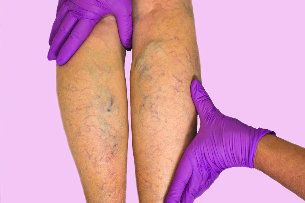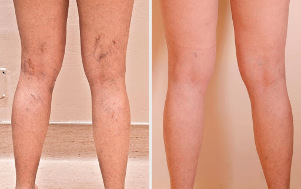It is a chronic disease of the veins, which is characterized by the thinning of their walls, the extension of the body, as well as the education of the nodes. Is found in 40% of women and 20% men.
It is a dangerous disease, mostly due to its complications. When used incorrectly or at the end of the treatment developed terrible state, such as thrombosis and thrombophlebitis, and bleeding of the dilated veins. Thrombosis total or partial closure of the lumen of the vein blood clot) or thrombophlebitis (inflammatory disease of the venous wall to the thrombosis) occurs suddenly, is not related to the exercise. The edema is spreading rapidly in the lower limb and is accompanied by arching of the pain. Can occur redness or blue, the sensitivity of the skin. In the case of detachment of a clot of blood, with the flow of the blood is in the vessels of the lungs, and in the case of the total or partial closure of the vessel is able to cause severe disease - pulmonary embolism. This complication is often fatal. If there is a suspicion of data complications, you should immediately take the horizontal position, lift a leg, by telephone contact with the service of emergency medical care. An injury in the expanded area of the vessels, bleeding may occur. In this case, it is urgent to impose a leg above the area of bleeding in the deck (a doctor or improvised), enough so that the hemorrhage has ceased, and that it is urgent to call an ambulance.
Thrombosis total or partial closure of the lumen of the vein blood clot) or thrombophlebitis (inflammatory disease of the venous wall to the thrombosis) occurs suddenly, is not related to the exercise. The edema is spreading rapidly in the lower limb and is accompanied by arching of the pain. Can occur redness or blue, the sensitivity of the skin. In the case of detachment of a clot of blood, with the flow of the blood is in the vessels of the lungs, and in the case of the total or partial closure of the vessel is able to cause severe disease - pulmonary embolism. This complication is often fatal. If there is a suspicion of data complications, you should immediately take the horizontal position, lift a leg, by telephone contact with the service of emergency medical care. An injury in the expanded area of the vessels, bleeding may occur. In this case, it is urgent to impose a leg above the area of bleeding in the deck (a doctor or improvised), enough so that the hemorrhage has ceased, and that it is urgent to call an ambulance.
The weakness of the muscular layer of the venous walls and the failure of the apparatus is converted into the reason that under the influence of the actions of the muscle pump," the blood begins to flow in the opposite direction, down. This leads to an increase of the pressure on the walls of the blood vessels, favoring the progression of the insufficiency of the valves, the extension of the light of the veins, and the education of the nodes. The muscle fibers of vein walls is atrophied, it disturbs the work of the nervous system receptors that regulate venous tone, which, in turn, reinforces the manifestations of the venous insufficiency. Risk factors for the development of the disease are: hereditary predisposition, pregnancy, obesity, the journal of a prolonged stay in a standing position or sitting, the activities related with the rise of weights, a systematic use of the clothing close, the corss, poor diet lack of content in the diet of fibers and vitamins, the violation of hormonal status.
The clinical manifestations of the
The main sign visible from the varicose disease is - SAC or a cylindrical extension of the superficial veins. Varicose veins in the legs are branched, protruding above the surface of the skin in the area of thighs and feet. The maximum of the varicose veins that are expressed after heavy or long-term physical loading. In an early stage of the disease bother fatigue, feeling of heaviness in the legs, burning sensation, the popping, the expressiveness of which is increased after physical load. May occur as transient swelling, plaintive laments the pain of the march of the veins. Turn to a professional, even in the initial phase, it will prevent the further development of the disease. The progression of the disease produces chronic venous insufficiency.
The diagnosis of varicose veins
"Gold" standard of diagnosis is considered to be the ultrasound of the veins of the lower extremities, in which are defined the affected areas of the veins. This principle is based on the classification anatomical of the varicose disease is, with indication of alteration of the vessel. For example, the defeat of the great saphenous vein above or below the knee, the small saphenous vein. In case of doubt, the data non-invasive methods employ the surgical methods of research, for example phlebography (contrast medium intravenously for the purpose of evaluating the state of the venous system).
The treatment of varicose veins
The non-surgical treatment of varicose veins of the lower limbs gives good results only in the debut of the disease, when the skin manifestations are not expressed and only moderately reduced work ability.
This surgical of the disease, the cure of which is only possible after the surgery:
- Phlebectomy - the early elimination of esophageal varices-extension of vienna. The aim of the operation is the removal of the injury of restoration of the blood by the removal of the main trunks of the great or small saphenous vein, as well as the ligation of the communicating veins. There are different types of operations. Apply almost always, even in difficult cases. In all these methods, it removes the part of vienna, which surprised, and the healthy segments of vienna saved. Vienna as exfoliate gently, and do not cut the tissues, which also reduces the operating of the injury. The same thing happens when using the surgical technique, and, in addition, less bruising, since the cold spasm reduces the amount of bleeding.
- Sclerotherapy - introduction to the extension of the vein special substance (sclerosant) which causes "sticking" of the wall of the vein with the cessation of the hemorrhage for it. As a result, there is no reset of the blood, eliminates the cosmetic defect, as well as vienna, disappear and become invisible. Sclerotherapy is effective only when the expansion of the small branches of the main trunks, which limits its application with a great expressiveness in the process. The advantage of sclerotherapy is the absence of scarring, the need for hospitalization. After sclerosing veins specific rehabilitation is not necessary.
- Coagulation by laser is a technique based on the destruction of the vein wall hot through exposure to the laser, so that it produces the "spike" lumen venous. It is shown only if the extension of vienna is not more than 10 mm Method is related to the conduct of the anesthesia. Aesthetically it is preferable, but as after the elimination of vienna requires early activation of the patient, as well as the long elastic compression.












































